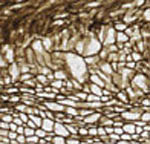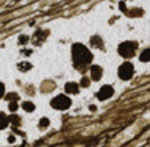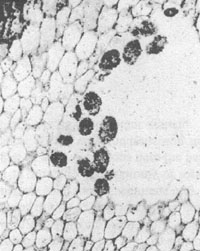No mite coprolites inside Vertebraria and Australoxylon
wood
The idea of orbatid mite coprolites in the Palaeozoic
seems to be so resilient to contrary evidence that it must be rejected
every time anew. (See "Wood rot or
coprolites". ) Although repeatedly presented arguments have
caused some palaeontologists to retreat half-heartedly by ascribing the
cell-size clots to "unknown creatures" [1] or "new detritivores" [2]
instead of oribatid mites [3], every now and then one stumbles upon
publications based on the old notions. One of such concerns two types
of Permian wood named Vertebraria
and Australoxylon,
referring to roots and stem of a glossopterid
tree, with "Galleries ... filled with ... spherical
coprolites ... from oribatid mites" [4]. Only a few details from images
in [4]
are sufficient to show that there are no "spherical
coprolites" and hence no "oribatid mites".



Figs.1,2,3: Alleged coprolites: Details from [4], Plate 5.1
and 5.3 (far right). Width of the pictures 0.5mm.
The clots seen here are not at all "spherical" but angular. They are
not of "uniform size" but vary in shape and size like the
(partially collapsed) cells of
the nearby tissue only 1mm away (Fig.2). Hence, most probably they
were formed inside cells as a kind of wood rot
and came out when the cell walls broke down.

Fig.4: Cell-size clots, alleged
coprolites in [5], shown here for comparison.
Judging from experience, the clots in Fig.3, although not as obviously
related to cells as those in Fig.4, do not look like coprolites. There
are two lengthy clots above and below in Fig.3 which seem to consist of
three cells in a row with dark fills.
The few details presented here reveal that essential claims in [4] lack
any fossil evidence:
"The coprolites in Vertebraria
and Australoxylon
occur in clusters of variable numbers."
"The morphology of these coprolites suggests
production by oribatid mites."
"Galleries in Vertebraria ...
filled with small clusters of spherical
coprolites are here interpreted to
derive from oribatid mites."
"Characteristics that particularly favour oribatid
mites as the originators of the small coprolites include their
clustered distribution, uniform size ..."
Obviously the publication [4] is fraught with a lot of
redundance and unsubstantiated statements inspired by wishful thinking.
This applies to [6], too. Also there are inconsistent size data. By
comparing the images 5 and 6
on Plate 5 it appears that at least one of the scale bars is erroneous.
Furthermore, the clots are not "120 µm long
and 115 μm wide" as claimed in Table 1 but 25...100µm
long and 25...75µm wide.
[4] refers to quite a number of other publications with
highly questionable inferences on
alleged oribatid mite coprolites which have been rejected before:
See Fossil
Wood News 16
and "Wood rot or coprolites".
Apparently no oribatid mite has ever been seen
along with the "coprolites". It would
be
interesting to know whether or not there are real oribatid
mite coprolites among the alleged ones. If not, the once favourite
subject should better fall into oblivion soon, or be remembered as a
folly of palaeobotanists who did not inspect their fossils carefully.
H.-J.
Weiss 2014
[1] M. Barthel,
M.
Krings, R. Rößler: Die schwarzen Psaronien von Manebach,
ihre Epiphyten,
Parasiten und Pilze.
Semana 25(2010), 41-60. (
recently re-named, former name: Veröff.
Naturhist. Mus. Schleusingen)
[2]
Zhuo Feng, Jun Wang, Lu-Yun Liu, R. Rößler: A
novel coniferous tree trunk with septate pith from the
Guadelupian (Permian) of China.
Int. J. Plant
Sci. 173(2012),
835–848.
[3] R.
Rößler:
The late palaeozoic tree fern
Psaronius - an ecosystem unto itself.
Rev. Palaeobot.
Palyn. 108(2000), 55-74.
[4] B.
Slater, S. McLoughlin, J. Hilton:
Animal–plant interactions in a Middle Permian permineralised peat ...,
Prince Charles Mountains, Antarctica.
Palaeogeogr. Pal. Pal. 363-364 (2012),
109-126.
[5] D.W.
Kellog, E.L. Taylor : Evidence of oribatid mite
detrivory in Antarctica during the Late Paleozoic and Mesozoic,
J. of Paleontology 78(2004), 1146-53.
[6] B.
J. Slater: Fossil Focus: Arthropod–plant
interactions.
Palaeontology [online] (2014), Vol.4,
Article 5.
|

|
 22 22 |

 22
22




 22
22